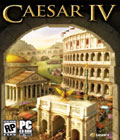Genre: Real-Time Strategy
Publisher: Vivendi
Developer: Tilted Mill
Release Date: September 26, 2006
The Caesar franchise has a long history that dates back to days of DOS games, with the original Caesar. There has been about an eight-year lapse since Caesar III, and the long-overdue fourth iteration of the series introduces some interesting changes while still adhering to the core gameplay. However, at its foundation, Caesar IV plays very similarly to the original games. This is not a bad thing, as it will retain fans of the series, but it will do little to attract newcomers to the genre. For those not familiar with the Caesar franchise, you govern cities and manage commerce, trade, and industry in the ancient Roman Empire.
Essentially, Caesar IV is similar to SimCity, except that it's set during the Roman time period, and there are some changes in economy and production. Constructing buildings and paying worker wages deducts money from your treasury, while taxes and trade collect income for your city. As governor of a city in the Roman Empire, you must watch over this precarious balance to create a thriving metropolis.
Another notable trait of Caesar IV is how it accounts for micro-economy. Each production building requires specific resources, and the game accounts for each individual resource that is gathered and spent; each piece of grain harvested must be taken to the market before your population has access to it. The game auto-manages the micro-economy for you, but at times, it can be a detriment. An example of how this can be a problem is when your warehouses are full and you can't remove stock to make room for other goods. Despite that, this level of depth can be quite engaging at times and helps draw the player into the role of governor.
As far as the city simulation aspect goes, it seems a bit sketchier than SimCity. The fact that the population is very fickle about what it wants and will often become unhappy, and that buildings can have a single unconnected road tile next to them and count as "having road access," are just a couple of examples of gameplay annoyances. My favorite scenario occurs when the Equites leave your city because nobody is fulfilling the job which they were supposed to do. Despite these drawbacks, Caesar IV still provides a fairly well-designed city simulation.
Caesar IV includes a number of campaigns through which to play. The initial campaign is a tutorial which teaches the game basics, and after that, there is a Normal campaign, as well as a Hard campaign for veteran players. In each, you play through a number of scenarios, and this objective style of gameplay is a nice change from the usual "build the biggest city" objective that accompanies most simulation titles. Although the scenarios provide direction to your city-building, you will soon find that the objectives get rather repetitive and could have benefited from more variety. Throughout the campaign, you will find that most scenarios are just variations of a few base archetypes, such as prepare a city's defenses for invasion, or establish an economic trade center. There are five ratings which judge your progress: culture, security, prosperity, favor with Rome, and population. Ultimately, attaining a certain rating in each of these categories will complete the mission. The win conditions vary for each scenario, and those with fairly high demands could easily take hours to complete, which means that a full campaign will have you playing the game for a good while. After all, Rome wasn't built in a day.
Your cities will be comprised of three classes of citizens in Caesar IV. Plebeians are the lower-class, hard-labor workers, Equites are the middle-class skilled labor workers, and Patricians are the rich, upper-class members of Roman society. With each class come requirements to maintain their happiness. Plebeians require only basic food and goods to sustain them, while on the other end of the spectrum, Patricians require luxury, exotic goods, and entertainment for them to flourish.
Each scenario starts out with a barren map. As the population of your city grows, you must manage housing, health care, commerce, industry, entertainment, and the other standard tasks that go along with city management. Caesar IV allows you to view a number of overlays which show statistics about areas of your city, such as security, water coverage, desirability, and others. Many of the amenities and utility buildings have a limited functional radius, so careful planning of your cities can save a lot of time and money in the end. Unfortunately, you can't see the effective radii of those buildings until you lay down the building and check the overlay view. The game partially makes up for it by including an "Undo" button, which affects your most recent action. The overall gameplay experience tends to be mixed, as the depth of the strategic simulation tends to be downtrodden a bit by user interface inconveniences.
The developers also included online multiplayer with two modes of play. The first is the "Caesar's Challenge," where players attempt various scenarios and compete for the highest scores. The second mode is a less competitive gameplay mode titled "The Empire," where players can build cities and submit them to a persistent empire; there is also a scenario editor for making your own missions and campaigns. These were beneficial additions to the game, which help set it apart from the standard city simulations.
If you are looking for in-depth strategic battles with Roman legions, then you should look elsewhere, as Caesar IV is very limited in the scope of combat. In your cities, you can house and train infantry legions for defense so when barbarians, Gauls, or other such ruffians attempt to invade your city, you can send out your legions to fend off the attack. Honestly, I never really saw much point in training legions though, as they take large quantities of resources and money to produce and maintain, while a few well-placed towers, combined with the town guard, can protect your city. If you're looking for a more combat-oriented title, then I would suggest Rome: Total War, which fills that role marvelously.
Caesar IV has some impressively detailed visuals to behold, assuming you're on the highest graphical settings. Unfortunately, it will chug on the highest settings unless you're running a pretty high-end system. However, the title still looks reasonably good on the medium and lower settings. The character animations seem rather limited, and many of the workers have a single animation that is continuously repeated. Granted, you won't be watching your individual workers with such scrutiny, as you will be more concerned with the overall city, so this represents a minor graphical annoyance. The Roman legions and military units are passable, but they don't stand up to the legionnaires in Rome: Total War. The game runs smoothly for the most part, with only a few minor issues, such as user interface bugs when you try to rotate building placement with the "Ctrl" key.
The audio of tends to be rather mixed in quality. The voices of the various people in your city are generally light-spirited and comical, albeit rather annoying at times. None of the voice-acting comes across as strikingly well done, but at the same time, it doesn't make you want to turn off the sound. The music is good and sets a nice mood for the gameplay, but the sound effects seem rather dull and lackluster.
If you're looking for a city-building simulation with a Roman pretense, which are in surprisingly high supply at the moment, then Caesar IV is a good choice. The overall design presents a good economic-based, city-building simulation with pleasing accompanying visuals. It will most likely prove more entertaining than CivCity: Rome or Glory of the Roman Empire, and as long as you don't expect epic Roman warfare, Caesar IV will bring you numerous hours of rewarding and enjoyable gameplay.
Score: 7.7/10
More articles about Caesar IV











 Caesar IV advances, refines and updates the city-building gameplay pioneered by Caesar III, while remaining true to its predecessor's proud legacy. In Caesar IV, players take on the role of an aspiring provincial governor within Caesar's empire as they build and manage an individual ancient Roman city and its province.
Caesar IV advances, refines and updates the city-building gameplay pioneered by Caesar III, while remaining true to its predecessor's proud legacy. In Caesar IV, players take on the role of an aspiring provincial governor within Caesar's empire as they build and manage an individual ancient Roman city and its province.








































